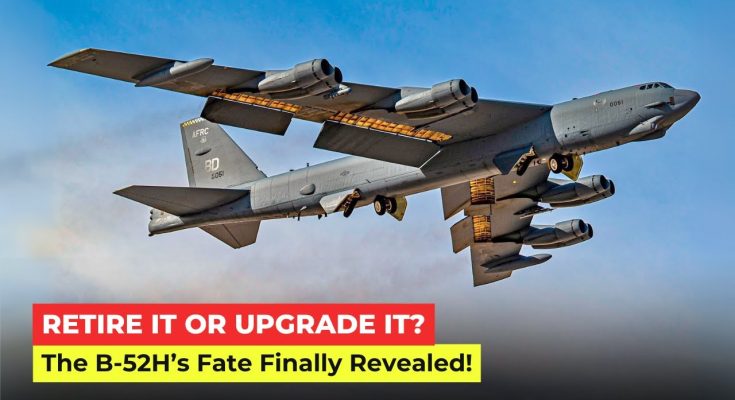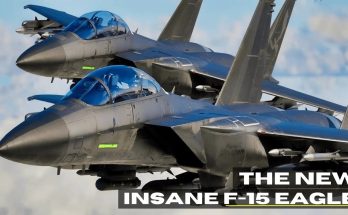Retire It or Upgrade It? The B-52H’s Fate Finally Revealed!
The B-52H Stratofortress, one of the most iconic aircraft in U.S. military history, has been a cornerstone of America’s strategic deterrence and long-range strike capabilities for over six decades. Its longevity is a testament to its adaptability and enduring performance, but as the years have gone on, the question has loomed: should the B-52H be retired, or should it be upgraded for continued service? The U.S. Air Force has finally made its decision: it’s time to upgrade the B-52H, ensuring that this legendary bomber remains in service for decades to come.
The B-52H’s Historic Legacy
First entering service in the 1950s, the B-52 has undergone numerous updates, evolving from a Cold War-era nuclear deterrent to a versatile platform capable of delivering conventional and precision-guided munitions. The B-52H variant, the most modern of the fleet, was introduced in the 1960s and has since become a symbol of American airpower. Despite its age, the B-52H has proven to be a remarkably reliable platform, capable of carrying a wide range of payloads, including nuclear weapons, cruise missiles, and a variety of bombs.
However, as the B-52H has aged, concerns about its aging systems, engines, and overall viability have surfaced. For years, the Air Force has debated whether to retire the aircraft or invest in substantial upgrades to extend its service life. Given the aircraft’s iconic status and unique role, the Air Force has opted for the latter.
The Decision to Upgrade
The decision to upgrade the B-52H instead of retiring it is driven by multiple factors, most notably cost-effectiveness and strategic necessity. Developing a completely new bomber to replace the B-52H would be an expensive and time-consuming endeavor. The U.S. Air Force is already in the process of introducing the B-21 Raider, a new, advanced stealth bomber that will play a key role in America’s future long-range strike capabilities. However, the B-21 is not expected to fully replace the B-52H in the near future, and the demand for long-range, versatile bombers remains high.
The B-52H’s ability to carry a wide array of weapons and its long range make it a valuable asset, especially when paired with the advanced capabilities of the B-21. Rather than completely retiring the B-52, the Air Force has chosen to upgrade its existing fleet, ensuring the bomber remains an effective and reliable part of the military for the foreseeable future.
Key Upgrades for the B-52H
The B-52H upgrade program, known as the B-52 Commercial Engine Replacement Program (CERP), is focused on modernizing the aircraft’s most critical systems. One of the major components of the upgrade is replacing the B-52’s aging engines with more fuel-efficient, reliable, and powerful commercial engines. This will not only extend the bomber’s service life but also enhance its performance, allowing it to operate more efficiently over long distances. The new engines will also help reduce maintenance costs, which have become increasingly high as the aircraft has aged.
Additionally, the B-52H will receive extensive avionics upgrades, including modern communications systems, navigation equipment, and new software to ensure compatibility with future weaponry and air defense systems. The updated avionics will improve the aircraft’s survivability in contested environments, ensuring it remains relevant in an increasingly complex and dynamic threat landscape.
The B-52H’s Role in the Future
Despite the arrival of the B-21 Raider, the B-52H will continue to play a key role in U.S. military operations. The B-52H’s versatility allows it to carry out a wide range of missions, from nuclear deterrence to conventional strikes, and its ability to deliver a large payload makes it an invaluable asset in both conventional and nuclear scenarios. The bomber’s longevity ensures that it will remain a part of the U.S. Air Force’s fleet alongside more advanced aircraft for decades to come.
While the B-21 Raider will take on the mantle of next-generation stealth and long-range strike, the B-52H’s proven capabilities and ongoing upgrades ensure that it will remain a vital part of the U.S. military’s strategic capabilities. The decision to upgrade the B-52H rather than retire it reflects the Air Force’s commitment to maintaining a diverse and flexible fleet of bombers, each with unique strengths and capabilities.
Conclusion
The B-52H Stratofortress, far from being retired, is poised to continue serving as a key component of the U.S. Air Force’s bomber fleet well into the 2050s. Through a series of upgrades to its engines, avionics, and weapon systems, the B-52H will remain a reliable and potent tool in the U.S. military’s arsenal. With the B-21 Raider set to complement, rather than replace, the B-52, the decision to upgrade the B-52H is a pragmatic one, ensuring that this storied bomber will continue to serve its country for years to come.



